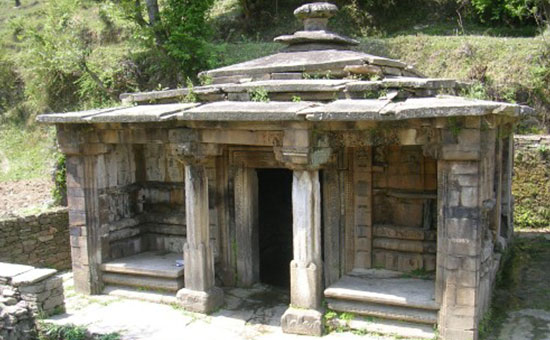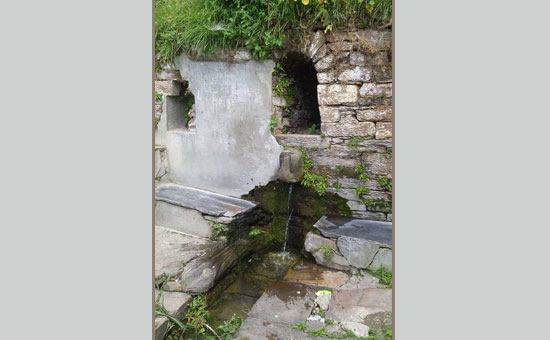- Article tells you about the Naul and Dhar system of Uttarakhand that provided water to the hilly people and was also a form of water-harvesting.
The harvesting system of water resources
and the well-maintained tradition of caring for them has been going on in our
country since time immemorial.
To read article in HINDI
In the Indus Valley Civilization, we find
many historical evidences of ancient water management. Evidence from excavation
shows that there used to be reservoirs at that time and the technique of drains
and wells for the drainage of rain water was also developed. Small dams of
pebble-stone and mud were also made in the water streams. These dams were used
for drinking water, irrigation and watermills.
Different practices of water harvesting
and management exist in different regions of India, which are still in practice
today. While Naul, Bauli, Pokhar and Kuhal are used for water in the
Himalayan region, Kund, Talab, Khadin in the desert, and Bandhara, Eri, Surangam in the southern
region are used. The geographical location of a particular region determines
the local water harvesting system and its conservation method.
Traditional sources of drinking water are
mainly natural sources of water in rural areas of Himalayan states like Arunachal
Pradesh, Meghalaya, Nagaland, Sikkim, Uttarakhand, Himachal Pradesh and Jammu &
Kashmir. Even today, about 40 percent of the rural population is dependent on
these waters. Many rural studies of the Himalayan region reveals that the first
settlement started in villages around water springs.
The natural water springs in Jammu and
Kashmir are known as Naag or Chashma and in Himachal Pradesh as Bawdi or Bauli. The water springs in Sikkim are called dhara.
The natural water springs in
Uttarakhand are known as Naul and Dhar or Mangra.
In Uttarakhand, the social, historical and
cultural importance of these Naul and
Dhar is very important. Many of the
Nauls here are very ancient. According to historians, most of the Naul and Dhar located in the Kumaon region of Uttarakhand have been made
from the medieval to the eighteenth century AD.
 Synarakot
Naul. Pic by Kaushal Saxsena.
Synarakot
Naul. Pic by Kaushal Saxsena.
A number of Nauls near Champawat including Ek
Hathiya Naul, Baleshwar Naul, Udia Naula of Gannath, Syunrakot Naul of Patia and Jahnavi Naul of Gangolihat are still
famous from an architectural view-point.
It is said that once there were more than
300 Naul'as in Almora town, which
were used by the urban people for drinking water. Many villages or mohallas of
Kumaon have also been named after the Naul
& Dhar, such as Panuvanaul, Champanaul, Tamnauli, Ranidhar, Dharnaul etc.
The rich tradition of Jal Pooja (worship of water) in Naul
& Dhar is performed on marriage
and other special occasions in the rural areas of the state. The tradition of Jal Pooja is still visible today in
Uttarakhand. Certainly this tradition shows the utility of water in our lives
and its importance in the environment.
NAUL
In fact, Naul is made at such a source where water reaches the ground by
leaking. The structure of Naul is
similar to that of a square small stepwell. The three directions of Naul are closed by the stone wall, the
fourth direction remains open. In order to prevent the dirt from going into the
Naul, it is protected by a slate roof,
called Pathar.
The shape of the Kund is like a Vedi which
remains more wide towards the top and gradually becomes less wide towards the
bottom.
Another form of Naul ie is found at some places is called Chupatol here. Chupatol
does not have the shape of a Naul. It
is found in the rough form and does not have a roof. It is made by making a pit
near the source ie stopped by flat stones.
The special point about the Naul that its springs are very sensitive. If an
unskilled person somehow manipulates the texture and basic technique at all,
then the springs of the naul's become
extinct. Not only this, the flow of water in the Naul is reduced even after landslides and earthquakes occur.
Sometimes the water level of Naul also reduces due to which it is on
the verge of drying. In the construction of the Naul, care is taken that extra water is not stored in it. For this,
a proper drainage system is made from inside. After reaching the level of the
upper floor of the Naul, excess water
comes out easily from this drain.
Murthies of Gods and Goddesses are installed in the sanctorum of Naul. The walls,
pillars and ceilings of Naul are
embellished with various artistic designs. According to religious belief, rural
people consider Naag Devta and Vishnu as the abode of God in Naul, so people take special care of its
cleanliness. Naul's description is also
found in local folk songs. In a Mangal geet,
the sanctity and importance of Naul
is told in this way.
'Naul Nagini vaas……
yeh meri naul kaili chinaichi
Ramichand lai, Lachhiman lai
Bharat, Shatur lai, chinaichi
unri bahuwan lai, Sita dehi
Uramini dulahini, naul ulainch. '
There is a curiosity among the people of
the village that who would have made this beautiful Naul the abode of the Nagas…. !! Then the Gidaris who sing the Mangal geet say that Lord Ramchandra and his brothers Lakshmana, Bharata and Shatrughna together have created this
beautiful Naul and Sita bahurani
and Urmila dulahini clean this Naul.
 Kapina Dhar. Pic by Author.
Kapina Dhar. Pic by Author.
Dhar or Mangra
Dhar or Mangra is the most popular source of traditional drinking water in Uttarakhand. When the underground water of a mountain comes out as a spout, then the people's make a stone or wooden drain's and drop its water on the ground in such a way that the water kept under it can be filled easily. In some of the ancient Dhars, their mouth was found to have the
main motif of Makara, Kamadhenu or Singh.
In rainy season, water level causes
springs to break out of the ground in many places. In such springs, water is
visible for a short time. The villagers put leaves at the exit gate of these
seasonal springs. Depending on the texture, many types of dhar are found locally in Uttarakhand, such as sirpatya dhar, munpatya dhar
and patbidiya dhar etc.
For centuries Naul & Dhar of
Uttarakhand had a direct and important role in the happiness and misery of the village
women folk. Women share their thoughts with each other while filling water in
these springs. From this point of view, the social significance of Naul and Dhar must be seen.
Many study reports reveal that the condition
of the traditional springs of Uttarakhand appears worrisome.
At one time, this tradition of water
harvesting gave cultural richness and vibrancy to the society. There was a
sense of collective participation in the maintenance of Naul-Dhar, the responsibility of their cleaning and renovation.
People used to participate in shramadaan with
great enthusiasm.
Today, due to migration, environmental
imbalance, lack of public participation and supply of water through pipelines
and tube wells, these traditional water springs have got neglected and are in
bad condition.
This is a big question mark for our society.
The need of the hour is that proper
policy-making efforts should be made to revive this magnificent tradition of
water harvesting. Such long-term plans should be implemented keeping the
society in mind and involve local people esp. in rural areas.
In order to keep the supply of water flow
in Naul & Dhar evergreen, it may be important to make chalk in the catchment
areas and plant trees of broad leaf varieties. Such work will not only ensure
the sustainable development of the environment, but also the proper protection
of this cultural property and tradition.
Today many social organizations and
environmental lovers are spreading awareness among the rural people about
conservation of naul and dhars.
Author works as a Research Associate at Doon Library and Research Center, 21, Parade Ground, Dehradun, and writes on a continuous basis on subjects related to socio-economic, environment, society and culture.